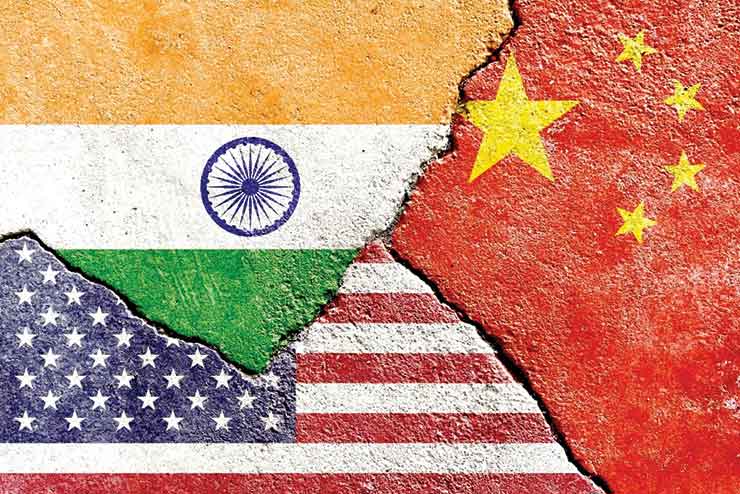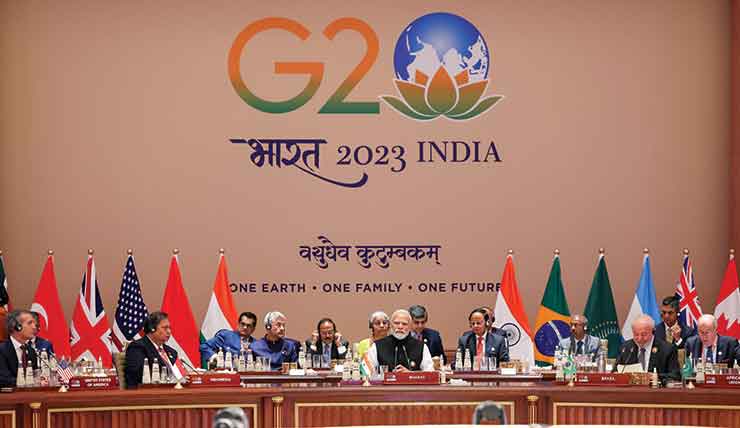
India is making significant strides in solidifying its position in the Asian age, particularly by bolstering its armed forces through a robust modernisation drive. Notable investments have been directed towards the Navy and the Air Force, with such key acquisitions as the INS Vikramaditya, INS Arihant, MMRCA, FFGA, Globe Master and Agni V&VI offering a glimpse into the future role of India’s military.
There is no doubt that South Asia constitutes an important sub-theatre of the Indo-Pacific region, both on land and at sea. Despite India’s position as the primary and dominant power in South Asia due to geography and history, the strategies of a proximate power like China and a distant power like the United States (US) are important in regional geopolitics. Furthermore, we cannot ignore the way the smaller states of South Asia, whether they are in the Himalayas or on the Indian Ocean’s littoral, manage their relations with India, the US, and China. In a time when Indo-Pacific tensions loom over South Asia, India-China relations are deteriorating, and US-China relations are falling apart, growing strategic cooperation between India and the US is seen in Beijing with some unease, leading to a complex dynamic of aspiring competition, doubtful cooperation, and arrogant confrontation.
In today’s world, India and the US have varying degrees of cooperation, competition, and conflict with China. As each country engages China, it prepares for a change in Chinese behaviour. Additionally, both countries acknowledge that China, especially with uncertainty about its behaviour, is partly driving the India-US partnership. In the US, a more substantial relationship with India and support of its rise has been driven by three imperatives: strategic interest, especially in light of China’s rise, economic interest, and shared democratic values. Some of the American interest in India is attributed to concerns about China’s aggressive rise. In recent years, tensions between the United States and China have introduced new challenges—especially related to economic and defence issues. China is a major trading partner for the United States but it is also developing its military capabilities, which poses challenges to the US congress in drafting a stringent policy towards China in Indo-Pacific. In today’s open market economy mainly driven by free trade agreements, the US goods and services trade deficit with China was USD 367.4 billion in 2022. This deficit makes us view the US as a doubtful distant power whose hegemony is being questioned in the Indo-Pacific region. However, an opportunistic China plans to dominate the market securing its economic and interest, while India is aspiring to join the bandwagon of Western nations with an aim to become a 5 trillion dollar economy. The G-20 summit hosted by India is testimony to this equation.
China’s security partnerships with India’s neighbours influence India’s strategic thinking because India and China are two proximate powers. Considering this looming shadow of the Indo-Pacific complex, the implications of China’s rise in South Asia are more relevant for a distant and equivocal power like the US
While the US played its cards of deepening ties with the East in a bid to secure its otherwise doubtful presence in the region, China missing the leaders’ summit suggests that it did so to avoid questions regarding its aggressive and confrontational attitude in the geo-political arena. Now, a key part of New Delhi’s own China strategy can be towards strengthening India both internally and externally (internal balancing) and building partnerships (external balancing) – and the US will play a key role in both.
Rewriting a Cold War Story
Global geopolitics in the 21st century is dominated by the rise of China and its strategic ramifications, particularly in the Indo-Pacific region. Analysts and policymakers have been paying attention to the dynamic between India and China – two proximate neighbours – given its implications for South Asia, a crucial sub-region of the Indo-Pacific. It makes sense for New Delhi to move closer to Washington as an aggressive and rising China seeks ingress into India’s territory and aims to increase its strategic footprint among South Asian countries. However, the emerging contours of US-China rivalry have led New Delhi and Washington to work together towards a strategic partnership, even though the US’s placement between the two contending nations is only of a mediator trying to placate both sides securing its national interest. Since 1949, China has remained a major factor in South Asia’s power balance. As a result, it has become a major concern for the US’ containment strategy in the region. During the early Cold War, India’s relationship with China and vice versa, as well as its potential partners in shaping the fate of a post-colonial Asia, played a crucial role.
Consequently, a large Asian country like China going communist was regarded as a failure for US strategy and with the Soviet Union going nuclear in the same year, as well as reverses the US suffered in the Korean War, the threat of communism became a paranoia in US policymaking circles. Despite Indian political leadership and US diplomatic establishment in India’s efforts to ease US concerns, there was apparent fear among the US government of newly independent Asian countries like India turning towards communism. According to the US government, ensuring India’s success, as a new nation-state, would serve as a good example of democracy in contrast to communism.

Navigating the India-US-China Triangle towards Regional Stability
As the multi-polar era grows, new terms of engagement between the US and its adversaries and partners have emerged. The US and India are stitching a closer strategic partnership, but independent powers like India have their unique worldview and intend to practice their strategic autonomy. Similarly, both Washington and New Delhi wish to preserve their sense of competition-cooperation balance with Beijing. This triangular interaction is influenced by geography amid power competition. Additionally, Chinese development and security partnerships with India’s immediate neighbours influence India’s strategic thinking and operations because India and China are two proximate powers. Considering this looming shadow of the Indo-Pacific complex, the implications of China’s rise in South Asia are more relevant for a distant and equivocal power like the US.
With China’s increasing economic and strategic interest in South Asia, such as through the Belt and Road Initiative (BRI), the neighbourhood has always played a prominent role in India’s foreign policy calculations. And in order to counteract China’s influence in South Asia, the US should pay attention to South Asia’s response to China’s BRI. Washington cannot match China’s investments in the region dollar for dollar, but it can provide alternatives along with a partner like India. An approach like this is also beneficial to India, who may not have the capability to provide public goods in South Asia.
With China’s increasing economic and strategic interest in South Asia, such as through the BRI, the neigh-bourhood has played a key role in India’s foreign policy calculations. To counter China’s influence in South Asia, the US should pay attention to South Asia’s response to China’s BRI
Regional Implication
As the India-US-China triangle and its interactions with regional permutations and combinations continue to evolve, New Delhi and Washington need to explore new and important areas of cooperation. Connectivity and infrastructure projects in South Asia are one of them requiring acute assessment and near-term implementation, given China’s inroads in the area. It is important that the US pays attention to the development gap in South Asia and collaborates with India, which understands what the region needs but may lack the material resources to build a viable strategy for the region.
However, a key concern for India was the cooperative aspects of Sino-US relations and thus chose to hedge between China and the US And with the US identifying China as a strategic competitor, India has increasingly embraced the Quad and leaned toward the US. As the US’s Indo-Pacific strategy leaves China facing two-front challenges, China’s security concerns about India have largely increased. Although smaller South Asian countries appear to be a balancing factor between India and China, the US’s growing Indo-Pacific rivalry cannot be dismissed.
Thus, to understand regional dynamics, India, the US, and China triangle merits the study with its roots in the early Cold War. Within the triangle, both capabilities and intentions influence perceptions and misperceptions. Resultantly, Indian power asymmetry compared to Chinese power and Chinese power gap compared to US power drive each state’s regional posture and trajectory.
–The writer is a professional and experienced writer having worked with multiple organisations. He is a keen observer of global affairs, geopolitics and how it affects the world order. The views expressed are of the writer and do not necessarily reflect the views of Raksha Anirveda















